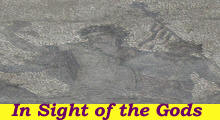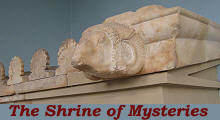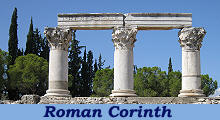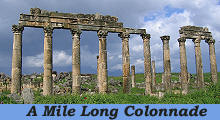  What's New! Detailed Sitemap All images © by Roberto Piperno, owner of the domain. Write to romapip@quipo.it. Text edited by Rosamie Moore. Page added in October 2010. |
  - Introduction and the Sanctuaries of Dion - Introduction and the Sanctuaries of Dion(Mosaic portraying Dionysus at Dion) Incumbent on the wings of wafting gales; The seat of gods; the regions mild of peace, Full joy, and calm eternity of ease. There no rude winds presume to shake the skies, No rains descend, no snowy vapours rise; But on immortal thrones the blest (2) repose; (1) Athena; (2) gods Homer - Odyssey - Book VI - Translation by Alexander Pope
We owe to Homer's poems the identification of Mount Olympus as the seat of the gods' council; from there they watched the events of the War of Troy; from there Athena rapidly descended to help Ulysses' return to Ithaca. Because the origin of Zeus and his brothers Poseidon and Hades is associated with Crete, the placing of the gods' residence on a mountain which is located at the opposite end of the Greek world is regarded as a sign of the country having been invaded by tribes (the Dorians) coming from the north. In more general terms initially the location of deities was associated with the deep of the forests (see a page on Dodoni), then with the highest mountains and finally with the clouds.
Heaved on Olympus tottering Ossa stood; On Ossa, Pelion (2) nods with all his wood. Such were they youths I had they to manhood grown Almighty Jove had trembled on his throne, But ere the harvest of the beard began To bristle on the chin, and promise man, His shafts Apollo aim'd; at once they sound, And stretch the giant monsters o'er the ground. (i) the Giants; (2) another mountain Homer - Odyssey - Book VI - Translation by Alexander Pope Mt. Olympus is composed of a compact group of mountains; its highest peaks almost reach 10,000 ft; it is separated from Ossa, a lower massif, by the Vale of Tempe, a deep gorge which was the main passage between classic Greece and Macedonia; in antiquity the gorge was celebrated as one of the seats of Apollo and the Muses; Emperor Hadrian visited it and in his Villa Adriana he built a nymphaeum inside a high wall in remembrance of the Pineios River which flows in the gorge. The map shows the fortress of Platamonas which controlled the northern entrance to the gorge.
The northern side of Mt. Olympus gently slopes towards the Macedonian plain; according to tradition Deucalion built an altar to Zeus on a site which is named Dion. In the Greek myth Deucalion played the same role as Noah in the Bible; he built an ark where he went with his wife to escape a flood which Zeus let loose on the earth to wipe out the whole race of man. Dion acquired importance in the Vth century BC when the Macedonian kings chose it to make their sacrifices to the gods.
In antiquity the coastline was closer to Dion than it is today and the town was linked to the Aegean Sea by a navigable river; the presence of some springs favoured the development of Dion as a privileged location for sanctuaries.
Dion was very dear to the kings of Macedonia and to Alexander the Great who went there to sacrifice to Zeus before starting out his Asian campaign; hecatombs, the sacrifice of a hundred oxen, took place along a very long altar to Zeus Olympios; the altar and Dion were burnt down in the late IIIrd century BC by the Aetolians who were allied with the Romans in the First Macedonian War. Dion returned to be an important town in the following centuries and in particular in the IInd and IIIrd centuries AD; the large majority of its monuments belong to that period; the city declined when the cult of the Olympian gods was prohibited; earthquakes caused its buildings to collapse and floods covered them with mud. First archaeological explorations were made in the XIXth century by Leon Heuzey and Honoré Daumet; today the ruins of Dion are surrounded by a beautifully arranged park, which makes up for the lack of the imposing (and very often reconstructed) monuments of more famous archaeological sites.
The sanctuary of Zeus Hypsistos was unearthed in 2003; the appellation is consistent with the role of Zeus in the Greek pantheon, but it is also indicative of a tendency to move from polytheism to monotheism which characterized the first centuries AD. The identification of Zeus as the supreme god, rather than a primus inter pares, was a step towards diminishing the relevance of other deities. In this sanctuary archaeologists have found many reliefs portraying eagles, a symbol of Zeus.
The sanctuary to Isis dates back to the IInd century AD, a time when Egyptian deities were extremely popular throughout the Roman Empire; their iconography however had no longer Egyptian features; Isis was identified by a particular knot (tyet) in her garment, which represented the union of divine and human forces.
The sanctuary replaced a previous one which was dedicated to Aphrodite, but this goddess was still honoured in a small nymphaeum adjoining the main temple, as traditionally the Romans placed statues of her at the centre of their fountains.
In theory Asclepius, a son of Apollo, was a minor deity, but because he was the god of medicine his popularity did not suffer from the growing importance of deities from Egypt or other countries of the eastern Mediterranean basin; his sanctuary at Dion was located near a pond because ritual baths were part of the prescribed therapy; an enkoimeterion has been identified near the sanctuary; in this building the patients slept and then told the priests their dreams.
Dion had a theatre excavated out of a small hill; in the IInd century AD, most likely at the time of Emperor Hadrian, the need for another theatre arose; this second theatre was entirely built with stones, bricks and mortars; it was not very large; it is possible that the old theatre was dedicated to gladiatorial fights, while the new facility was reserved for music and poetry contests. The sanctuaries, the theatres and a stadium were located in an area to the east of the town. Move to page two to see the town of Dion or to page three which covers the Fortress of Platamonas. Clickable Map of the Ionian and Aegean Seas with links to other locations covered in this website (opens in a separate window) SEE THESE OTHER EXHIBITIONS (for a full list see my detailed index).    |









